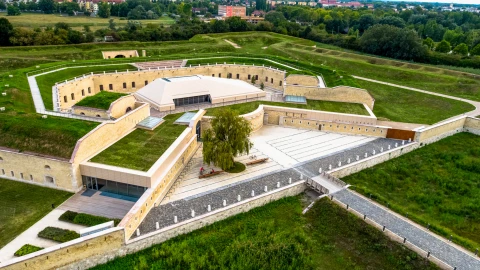
Star Fortress in Komárom
The Komárom Star Fortress has been comprehensively reconstructed and expanded as part of the Liget Budapest Project,. The project has returned one of the most significant groups of buildings in the Komárom fortification system, which in the late 1800s was the largest military complex in Central Europe, to its original, historically accurate state. Through the reconstruction, the fortress has also become the site of a new cultural centre encompassing more than 7000 square metres, where outstanding pieces from the Museum of Fine Arts' neglected collection of several hundred plaster replicas will finally find a worthy home after seven decades. Now that the building is ready, the process of moving in the artworks can begin: the new facility will carry out educational and instructional functions in the setting of a modern interactive museum, meaning that the Star Fortress will be opened to the public as a truly family-friendly cultural institution in the spring of 2020.
The reconstruction and expansion of the Komárom Star Fortress has been completed as part of the Liget Budapest Project, Europe's largest cultural development project.
The two years of work – based on the designs of Ybl Award-winning architect István Mányi – have included a complete overhaul of the fortress building and its surroundings, expanding it to include a new multi-functional cultural center with modern exhibition space that will result in a 7,000 square metre net increase in the floor space of the existing building. This building is where the nearly 300 outstanding pieces from the Museum of Fine Arts' neglected collection of plaster replicas – copies of outstanding works from the world of sculpture from antiquity to the Renaissance – will find a home. After the institution opens its doors, visitors will get to marvel at works like the equestrian statues of Bartolomeo Colleoni and Gattamelata by Andrea del Verrocchio and Donatello, respectively, both of them replicas of several metres in height, along with medieval and Renaissance tombs, the Venus di Milo, the Laocoön statue group and several sculptures by Michelangelo.
There is no doubt about it that there are few fine arts collections in the country that have undergone as many severe trials as the set of plaster replicas that was stored in the Romanesque Hall of the Museum of Fine Arts after being created in the early 20th century with the aim of showing the public a comprehensive history of sculpture through faithful copies of important works.
Much of the material has been in storage for more than seven decades, spread out across the country, with many of the pieces having suffered major damage. The current development project is a solution to this problem: a large portion of the collection – after the required restoration work has been completed – will end up in Komárom's expanded Star Fortress, with a smaller part of it going to the National Museum Restoration and Storage Centre.
The work on the building completed, the process of moving in and installing the large-scale statues and setting up the permanent exhibition can begin. The new facility will carry out educational and instructional functions in the setting of a modern interactive museum, meaning that it will be opened to the public as a truly family-friendly cultural institution in the spring of next year.
About the renovation
Renovated and endowed with a cultural centre, the Star Fortress will welcome school groups and families visiting from all over the country, whom it will offer a rich and exciting interactive programme.Before the renovation work started, the blueprints for the fortress were found in the military archives in Vienna, which allowed the building – where possible – to be restored to its original state. The new and expanded complex will also feature, along with galleries that meet 21st-century requirements, a screening room/auditorium, a museum shop focusing on museum pedagogy and a café. The embrasures where cannons and rifles could be fired outwards have been restored to their historical state, and the courtyard has been fitted out so that it can also be used as an open-air theatre.
In the course of the two-year renovation project, 32,000 cubic metres of earth were moved, 1,200 square metres of stone surface were restored, and a total of 115,000 bricks were laid.